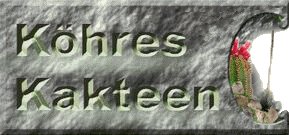|
Cactus and Succulent seeds
For germination of cactus seeds three conditions are required: light, heat and humidity.
We are getting best germination results with a mix of peat and sand. Cacti like to have a little bit light for germination, but no direct sunlight. In the first 4-8 weeks the pot is heavily shaded with paper, so you have a diffuse light and this will also reduce the growth of algae. The best temperature range for germination is between 15 °C and 35 °C. Some species need frost for germination, especially different american varieties which grow in high altitudes, and various species of Opuntia. The Cactus Societies have already been published many articles with germination problems of difficult species. A temperature above 25 °C is favorable to reduce harmful fungi, at night temperature can be temporarily lower.
In many cases of some various seeds Chinosol has been responsible for a bad germination result and should not be used for sowing, in order to prevent a later fungal infection "Malvin" (active ingredient "Captan") has been prooved. In the first two weeks, the soil should be moist, but not wet. In any case you should avoid drying out the soil. I keep my seedlings at least 4 weeks closed, thereby there is no drying, algae and fungi will be avoided from outside. It is necessary, that you look after your seedlings in the first 4 weeks. The irrigation is done from below, to prevent a silting and crusting of the soil. The substrate should be a permeable mixture, which can be sterilized damped in a glas. For years I use successfully finely screened crushed pumice, which is simple to keep moist and to prevent dammed wet.You can use even finely sieved flower soil with about 10% sand for sowing. For a further culture you can use another substrate. The seed is scattered on the substrate and lightly pressed, covered in no case, that will prevent or delay the germination. The distance between the seeds should be the 2-3 times thickness of the seeds. Most of the seeds should germinate within the first 2 weeks. Some species germinate after two or three days, others require a longer germination period. Especially Mammillarias germinate in spurts with long intervals. Fresh seeds of mostly large-flowered Mammillarias like M. goldii, M. haudeana, M. luethyi, M. theresae and M. saboe do have a germ barrier. If the seeds do not germinate on the first attempt, dry the seeds a few days and try it again, a safe method for germination of these seeds is not found until now. Some succulent seeds should be covered well, they do not need light for germination. The sowing of Anacampseros, Conophytum, Echeveria, Crassulacea, Lithops and Mesembryanthemum should not have a temperature above 20 °C until germination. Seeds should not be covered. Dinteranthus requires up to 3 months to germinate. Seeds of Tillandsia are put on a plastic mesh and sprayed at least 2 times a day with soft water. After 2 weeks you can fertilize the seeds with a complete fertilizer (0.01%). For seeds of Euphorbia and other succulents there are the same rules as above, but they should have after germination more air and light. Palms, Dracaena, Asperagus, Sophora and Musa have to be cleaned of their pulp. After that you have to swell the seeds in about 25 °C hot water. Then the seeds are put on a peat-sand mixture and they should be covered with substrate as thick as the seeds are. Pachypodium need to germinate 25-30 °C and a very high humidity. Cissus and Testudinaria germinate best at short days at 25-30 °C or the seeds have to be covered with black tape and need a lot of moisture. Nepenthes are sown on peat, germination takes 6-8 weeks.
I hope, I could give you some tips and wish you much success and joy of sowing.
Gerhard Köhres
Sowing instructions onions:
|



